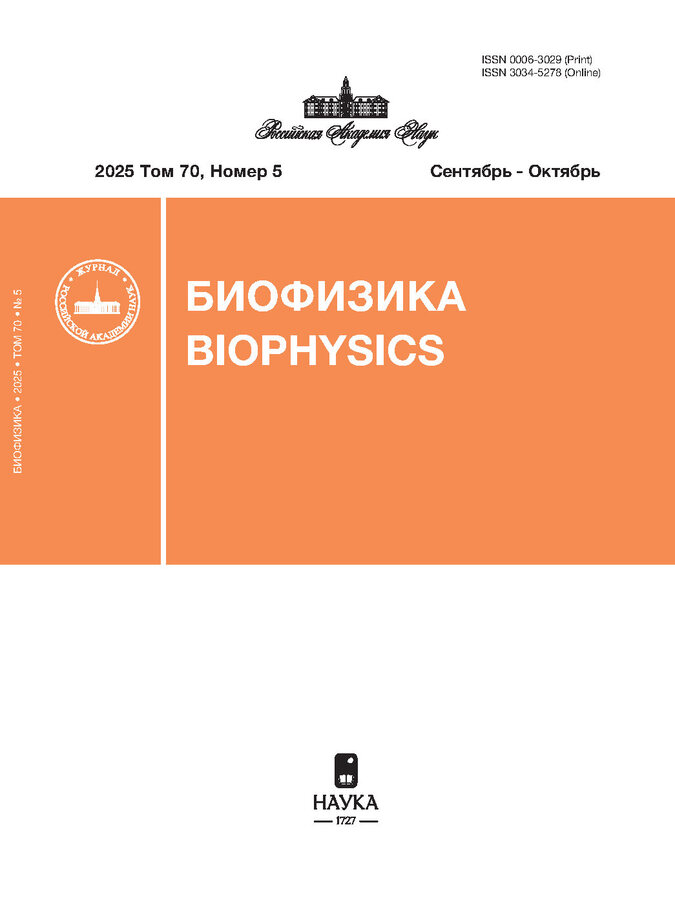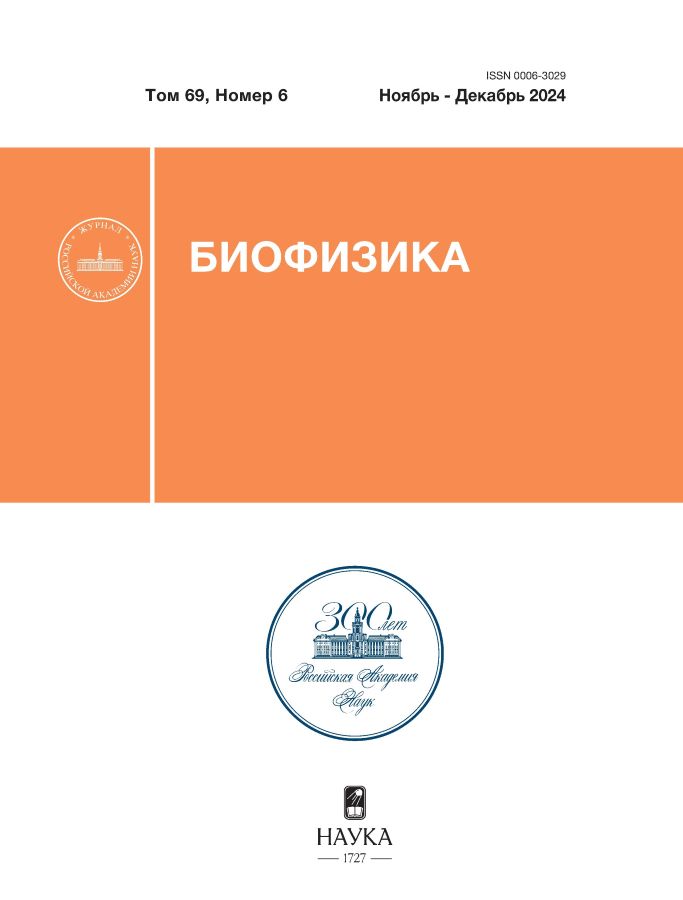Investigation of the Functional State of Heart Mitochondria in Inbred Mice with Type 2 Diabetes Mellitus
- Authors: Baburina Y.L1, Odinokova I.V1, Krestinin R.R1, Zvyagina A.I1, Sotnikova L.D1, Krestinina O.V1
-
Affiliations:
- Institute of Theoretical and Experimental Biophysics, Russian Academy of Sciences
- Issue: Vol 69, No 6 (2024)
- Pages: 1195-1205
- Section: Cell biophysics
- URL: https://rjdentistry.com/0006-3029/article/view/676135
- DOI: https://doi.org/10.31857/S0006302924060062
- EDN: https://elibrary.ru/NLUUQB
- ID: 676135
Cite item
Abstract
About the authors
Y. L Baburina
Institute of Theoretical and Experimental Biophysics, Russian Academy of SciencesPushchino, Russia
I. V Odinokova
Institute of Theoretical and Experimental Biophysics, Russian Academy of SciencesPushchino, Russia
R. R Krestinin
Institute of Theoretical and Experimental Biophysics, Russian Academy of SciencesPushchino, Russia
A. I Zvyagina
Institute of Theoretical and Experimental Biophysics, Russian Academy of SciencesPushchino, Russia
L. D Sotnikova
Institute of Theoretical and Experimental Biophysics, Russian Academy of SciencesPushchino, Russia
O. V Krestinina
Institute of Theoretical and Experimental Biophysics, Russian Academy of Sciences
Email: ovkres@mail.ru
Pushchino, Russia
References
- Дедов И. И., Шестакова М. В., Викулова О. К., Железнякова А. В., Исаков М. А., Сазонова Д. В. и Мокрышева Н. Г. Сахарный диабет в Российской Федерации: динамика эпидемиологических показателей по данным Федерального регистра сахарного диабета за период 2010 — 2022 гг. Сахарный диабет, 26 (2), 104-123 (2023). doi: 10.14341/DM13035
- Huss J. M. and Kelly D. P. Mitochondrial energy metabolism in heart failure: a question of balance. J. Clin. Invest., 115 (3), 547-555 (2005). doi: 10.1172/JCI24405
- Schilling J. D. The mitochondria in diabetic heart failure: from pathogenesis to therapeutic promise. Antioxid. Redox Signal., 22 (17), 1515-1526 (2015). doi: 10.1089/ars.2015.6294
- Halestrap A. P. What is the mitochondrial permeability transition pore? J. Mol. Cell. Cardiol., 46 (6), 821-831 (2009). doi: 10.1016/j.yjmcc.2009.02.021
- Riojas-Hernandez A., Bernal-Ramirez J., Rodriguez-Mier D., Morales-Marroquin F. E., Dominguez-Barragan E. M., Borja-Villa C., Rivera-Alvarez I., and Garcia-Rivas G., Altamirano J., Garcia N. Enhanced oxidative stress sensitizes the mitochondrial permeability transition pore to opening in heart from Zucker Fa/fa rats with type 2 diabetes. Lfe Sci., 141, 32-43 (2015). doi: 10.1016/j.lfs.2015.09.018
- Loson O. C., Song Z., Chen H., and Chan D. C. Fis1, Mff, MiD49, and MiD51 mediate Drp1 recruitment in mitochondrial fission. Mol. Biol. Cell, 24 (5), 659—667 (2013). doi: 10.1091/mbc.E12-10-0721
- Yu T., Jhun B. S., and Yoon Y. High-glucose stimulation increases reactive oxygen species production through the calcium and mitogen-activated protein kinase-mediated activation of mitochondrial fission. Antioxid. Redox Signal., 14 (3), 425-437 (2011). doi: 10.1089/ars.2010.3284
- Yu T., Sheu S. S., Robotham J. L., and Yoon Y. Mitochondrial fission mediates high glucose-induced cell death through elevated production of reactive oxygen species. Cardiovasc. Res., 79 (2), 341-351 (2008). doi: 10.1093/cvr/cvn104
- Yang X., Pan W., Xu G., and Chen L. Mitophagy: A crucial modulator in the pathogenesis of chronic diseases. Clin. Chim. Acta, 502, 245-254 (2020). doi: 10.1016/j.cca.2019.11.008
- Крестинин Р. Р., Бабурина Ю. Л., Одинокова И. В., Сотникова Л. Д. и Крестинина О. В. Действие астаксантина на функциональное состояние митохондрий мозга крыс при сердечной недостаточности. Биофизика, 67 (5), 917-925 (2022). doi: 10.31857/S0006302922050088
- Baburina Y., Krestinin R., Odinokova I., Fadeeva I., Sotnikova L., and Krestinina O. The identification of prohibitin in the rat heart mitochondria in heart failure. Biomedicines, 9 (12), 1793 (2021). doi: 10.3390/biomedicines9121793
- Verma S. K., Garikipati V. N. S., and Kishore R. Mitochondrial dysfunction and its impact on diabetic heart. Biochim. Biophys. Acta — Mol. Basis Dis., 1863 (5), 10981105 (2017). doi: 10.1016/j.bbadis.2016.08.021
- Shubin A. V., Demidyuk I. V., Komissarov A. A., Rafieva L. M., Kostrov S. V. Cytoplasmic vacuolization in cell death and survival. Oncotarget, 7 (34), 55863-55889 (2016). doi: 10.18632/oncotarget.10150
- Karabulut D., Akin A., Kaymak E., Öztürk E., and Sayan M. Histological examination of rat heart tissue with chronic diabetes. Exp. Appl. Med. Sci., 1 (1), 17-22 (2020). DOI.org/10.46871/eams.2020.2
- Schoeman R., Beukes N., and Frost C. Cannabinoid combination induces cytoplasmic vacuolation in MCF-7 breast cancer cells. Molecules, 25 (20), 4682 (2020). doi: 10.3390/molecules25204682
- Bombicino S. S., Iglesias D. E., Mikusic I. A. R., D'Annunzio V., Gelpi R. J., Boveris A., and Valdez L. B. Diabetes impairs heart mitochondrial function without changes in resting cardiac performance. Int. J. Biochem. Cell Biol., 81 (Pt B), 335-345 (2016). doi: 10.1016/j.biocel.2016.09.018
- Koentges C., Konig A., Pfeil K., Holscher M. E., SchnickT., Wende A. R., Schrepper A., Cimolai M. C., Kersting S., Hoffmann M. M., Asal J., Osterholt M., Odening K. E., Doenst T., Hein L., Abel E. D., Bode C., and Bugger H. Myocardial mitochondrial dysfunction in mice lacking adiponectin receptor 1. Basic Res. Cardiol., 110 (4), 37 (2015). doi: 10.1007/s00395-015-0495-4
- Itoh T., Kouzu H., Miki T., Tanno M., Kuno A., Sato T., Sunaga D., Murase H., and Miura T. Cytoprotective regulation of the mitochondrial permeability transition pore is impaired in type 2 diabetic Goto-Kakizaki rat hearts. J. Mol. Cell Cardiol., 53 (6), 870-879 (2012). doi: 10.1016/j.yjmcc.2012.10.001
- Oliveira P. J., Seica R., Coxito P. M., Rolo A. P., Palmeira C. M., Santos M. S., and Moreno A. J. Enhanced permeability transition explains the reduced calcium uptake in cardiac mitochondria from streptozotocin-induced diabetic rats. FEBS Lett., 554 (3), 511-514 (2003). doi: 10.1016/s0014-5793(03)01233-x
- Hu L., Ding M., Tang D., Gao E., Li C., Wang K., Qi B., Qiu J., Zhao H., Chang P., Fu F., and Li Y. Targeting mitochondrial dynamics by regulating Mfn2 for therapeutic intervention in diabetic cardiomyopathy. Theranostics, 9 (13), 3687-3706 (2019). doi: 10.7150/thno.33684
- Peyravi A., Yazdanpanahi N., Nayeri H., and Hosseini S.A. The effect of endurance training with crocin consumption on the levels of MFN2 and DRP1 gene expression and glucose and insulin indices in the muscle tissue of diabetic rats. J. Food Biochem., 44 (2), e13125 (2020). doi: 10.1111/jfbc.13125
- Jezek P. and Dlaskova A. Dynamic of mitochondrial network, cristae, and mitochondrial nucleoids in pancreatic ß-cellsMitochondrion, 49, 245-258 (2019). doi: 10.1016/j.mito.2019.06.007
- Yu J., Maimaitili Y., Xie P., Wu J. J., Wang J., Yang Y. N., Ma H. P., and Zheng H., High glucose concentration abrogates sevoflurane post-conditioning cardioprotection by advancing mitochondrial fission but dynamin-related protein 1 inhibitor restores these effects. Acta Physiol. (Oxford)., 220 (1), 83-98 (2017). doi: 10.1111/apha.12812
- Liu R., Jin P., Yu L., Wang Y., Han L., Shi T., and Li X. Impaired mitochondrial dynamics and bioenergetics in diabetic skeletal muscle. PLoS One, 9 (3), e92810 (2014). doi: 10.1371/journal.pone.0092810
- Liu P., Lin H., Xu Y., Zhou F., Wang J., Liu J., Zhu X., Guo X., Tang Y., and Yao P. Frataxin-mediated PINK1-Parkin-dependent mitophagy in hepatic steatosis: The Protective effects of quercetin. Mol. Nutr. Food Res., 62 (16), e1800164 (2018). doi: 10.1002/mnfr.201800164
- Tang Y., Liu J., and Long J. Phosphatase and tensin homolog-induced putative kinase 1 and Parkin in diabetic heart: Role of mitophagy. J. Diabetes Investig., 6 (3), 250255 (2015). doi: 10.1111/jdi.12302
- Xu X., Kobayashi S., Chen K., Timm D., Volden P., Huang Y., Gulick J., Yue Z., Robbins J., Epstein P. N., and Liang Q. Diminished autophagy limits cardiac injury in mouse models of type 1 diabetes. J. Biol. Chem., 288 (25), 18077-18092 (2013). doi: 10.1074/jbc.M113.474650
Supplementary files











